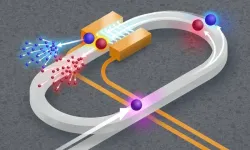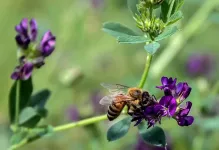(Press-News.org) The genetic plans within our DNA come to functional fruition through proteins, which underlie our bodies’ structure and activity. Yet, the proteome – all the proteins within a cell or given area – remains relatively mysterious because protein landscapes are incredibly complex. Humans, for example, make tens of thousands of different proteins.
To help decipher this complexity, a team of Stanford University researchers has led the development of a new method, called TransitID, for tracking the complete activity of proteins in living cells. This method is detailed in a paper published June 28 in Cell.
Existing techniques for this task, microscopy, and mass spectrometry proteomics, either allow scientists to study only a handful of proteins at a time in a live cell, or provide a very detailed, but still, snapshot of all the proteins in a dead cell.
“Our new technique allows you to combine the strengths of both microscopy and mass spectrometry proteomics by actually looking at living samples – including their dynamics as they move and function – and seeing in an unbiased way all of the proteins at once,” said Alice Ting, professor of genetics at Stanford Medicine and of biology in the School of Humanities and Sciences, who is senior author of the paper. “There haven’t been methods that combined those strengths before.”
TransitID also works on proteins that move between cells. Tracking proteins at this level of detail and liveliness could unveil untold information about how cells communicate. In addition, there are obvious applications for research into various diseases and treatments, including in the realms of cancer and neurodegenerative diseases.
“It’s exciting that there are such broad applications for this,” said Joleen Cheah, a PhD candidate at Stanford and co-lead author of the paper. “We’ve already received many inquiries about TransitID and established many collaborations with other labs that are interested in using it.”
Tracing a collective journey
In very simple terms, TransitID tracks all the proteins along a specific journey by tagging all the molecules within a certain radius of chosen beginning and end locations. First, two enzymes developed previously by the Ting lab, called TurboID and APEX, are placed at each end of the journey. When the researchers are ready to begin their protein monitoring, they introduce the B vitamin biotin, which causes TurboID to spray biotin on all the surrounding molecules – including proteins – tagging them. The researchers then wash the cell of excess biotin and allow it to go about its usual activity. When they think the proteins have had enough time to travel, they then add the chemical compound alkyne-phenol, which causes the same spraying action on the APEX end.
The researchers interpret the individual excursions of the proteins that moved between the tagged locations by breaking down the cell membrane and analyzing the contents. Some proteins will never have moved, either having only TurboID tags or only APEX tags. Those that have both, made the journey between. And anything without a tag resided beyond the journey of interest.
Four experiments, one surprise
In order to test their tool, the researchers first conducted two experiments detailing known protein activity. They monitored proteins that moved between the fluid of the cytoplasm (the cytosol) to the mitochondria, which exist in contrast to proteins that are the product of mitochondrial DNA and therefore originate in the mitochondria. In the next experiment, the researchers tracked how protein movement from the cytosol to the nucleus changes when a cell undergoes oxidative stress. The results from both of these experiments turned out as expected, which meant TransitID was working successfully.
Next, the researchers used their technique to investigate protein traffic to parts of the cell that are not bound by membranes – specifically, stress granules, which are condensations of proteins and RNAs that form in response to cellular stress.
“Biomolecular condensates, such as stress granules, are highly dynamic structures that rapidly and continually exchange constituents with related structures. TransitID allows us for the first time to track the fate of these constituents,” said J. Paul Taylor, scientific director and executive vice president at St. Jude Children’s Research Hospital, who is co-author of the paper.
The results of this experiment were surprising. As the researchers were analyzing the proteome of the stress granules, they found JUN, a well-known transcription factor that is upregulated/overexpressed in multiple cancers.
“No one has ever found it in stress granules before,” said Ting. “So, when we found it there, we almost didn’t trust it.”
After confirming its presence, the researchers probed further and determined that JUN seemed to be in the stress granule as a protection mechanism. They found that, under oxidative stress, JUN relocates to the stress granule to avoid its alternative stress response – aggregating and then being disposed of for being an unwelcome aggregated mess – which keeps JUN healthy and available to resume its work once the stress is over.
The last experiment with TransitID included in this paper tracked protein activity between macrophages and cancer cells, which exists in a notoriously complex and noisy protein environment.
Improving on great potential
With thousands of requests for TurboID and APEX already received from labs around the world in response to previous work, the researchers know their new take on these existing favorites is bound to enable thrilling results in both foundational and applied science.
“I expect this approach to be rapidly adopted by a broad array of scientists, similar to other innovative techniques developed in Alice’s lab,” said Taylor. “This tool is a particularly important breakthrough enabling the investigation of condensates because they are highly dynamic structures.”
“I’m excited about the simplicity of the method and how accessible it is, given what’s already out there,” said Ting. “It uses commercially available reagents and people don’t have to do any organic chemistry in their own labs to use the method, and yet they can access totally new biology that wasn’t visible before.”
The team still sees room for improvement, specifically aiming to optimize their process and rely on less toxic chemicals. For now, TransitID is limited to being used in cell cultures but, with gentler chemicals, it could be used to track detailed protein dynamics in living animals.
Wei Qin, a former postdoctoral scholar in the Ting lab, is co-lead author of this paper. Additional co-authors are from the Broad Institute of MIT and Harvard; St. Jude Children’s Research Hospital; the Baylor College of Medicine; and Texas Children’s Hospital. Ting is also a Chan Zuckerberg Biohub investigator, a member of Stanford Bio-X, the Maternal & Child Health Research Institute (MCHRI), the Stanford Cancer Institute, and the Wu Tsai Neurosciences Institute, and a faculty fellow of Sarafan ChEM-H.
This research was funded by the National Institutes of Health, the Stanford Wu Tsai Neurosciences Institute, the National Science Foundation, the Stanford Gerald J. Lieberman Fellowship, the Dr. Miriam and Sheldon G. Adelson Medical Research Foundation, the Howard Hughes Medical Institute, and Cancer Prevention and Research Institute of Texas.
END
Tracking protein traffic in living cells
2023-06-29
ELSE PRESS RELEASES FROM THIS DATE:
Historical Redlining May Be Linked to Current Kidney Failure
2023-06-29
FOR IMMEDIATE RELEASE
Contact:
Jillian McKoy, jpmckoy@bu.edu
Michael Saunders, msaunder@bu.edu
##
Historical Redlining May Be Linked to Current Kidney Failure
New study shows that long-term disinvestment in health and wealth resources in historically redlined neighborhoods likely contributes to a disproportionate rate of kidney failure among Black adults today.
Living ...
IceCube shows Milky Way galaxy is a neutrino desert
2023-06-29
The Milky Way galaxy is an awe-inspiring feature of the night sky, dominating all wavelengths of light and viewable with the naked eye as a hazy band of stars stretching from horizon to horizon. Now, for the first time, the IceCube Neutrino Observatory has produced an image of the Milky Way using neutrinos — tiny, ghostlike astronomical messengers.
In a June 30 article in the journal Science, the IceCube Collaboration — an international group of more than 350 scientists — presents this new ...
Scientists edge toward scalable quantum simulations on a photonic chip
2023-06-29
Scientists have made an important step toward developing computers advanced enough to simulate complex natural phenomena at the quantum level. While these types of simulations are too cumbersome or outright impossible for classical computers to handle, photonics-based quantum computing systems could provide a solution.
A team of researchers from the University of Rochester’s Hajim School of Engineering & Applied Sciences developed a new chip-scale optical quantum simulation system that ...
Push to green energy is not without consequences, PSU prof explores
2023-06-29
From a proposed lithium mine near the Oregon-Nevada border to a proposed pumped hydropower facility in Washington, the transition from fossil fuels to renewables is not all clean and green. The extraction, manufacturing, storage and recycling of metals and minerals needed for electric cars, wind and solar has impacts on land, water, wildlife and people — and thanks to a new grant, a Portland State professor will take a closer look at those impacts, both good and bad.
Alida Cantor, associate professor of geography, ...
Honey bees more faithful to their flower patches than bumble bees
2023-06-29
Kim Kaplan
301-588-5314
Kim.Kaplan@usda.gov
Honey Bees More Faithful to Their Flower Patches Than Bumble Bees
MADISON, WI, June 29, 2023—Honey bees are more faithful to their flower patches than bumble bees when it comes to returning to collect more pollen and nectar, according to a study by U.S. Department of Agriculture Agricultural Research Service scientists.
Overall, 76 percent of honey bees in the study revisited the same plot of alfalfa flowers in contrast to just 47 percent of eastern bumble bees.
But size does matter, especially to bumble bees. They were more faithful to larger flower patches, while the likelihood of honey bees returning to a flower patch ...
Where there’s smoke, there’s fire – and normal numbers of national park visitors
2023-06-29
More Americans than ever are heeding the call of the outdoors – spending time recreating outside and enjoying national parks. Simultaneously, smoky skies are worsening as the size and severity of wildfires increase and adversely affect air quality across the country.
Wildfire smoke threatens human health and welfare, especially if humans are exposed to smoke for long periods or while exercising – such as during a hiking trip to one of America’s beloved national parks.
Matthew Clark, a doctoral student at Boise State University studying how social and environmental ...
HIV patients in DC reported intense distress during pandemic
2023-06-29
The COVID-19 pandemic had substantial psychological impacts on the nation and around the world. New research shows patients with HIV were particularly susceptible to psychosocial challenges like depression, anxiety, substance abuse, loneliness and more. The study was co-authored by HIV/AIDS expert Michael Horberg, MD, and published in AIDS Research and Therapy.
Researchers analyzed the results from a 2020 survey of nearly 900 Washington, D.C.-based participants diagnosed with HIV. The survey asked patients to rate the degree to which they experienced challenges with financial stability, mental health, social connections ...
Researchers teach an AI to write better chart captions
2023-06-29
Chart captions that explain complex trends and patterns are important for improving a reader’s ability to comprehend and retain the data being presented. And for people with visual disabilities, the information in a caption often provides their only means of understanding the chart.
But writing effective, detailed captions is a labor-intensive process. While autocaptioning techniques can alleviate this burden, they often struggle to describe cognitive features that provide additional context.
To help people author high-quality chart captions, MIT researchers have developed a dataset to improve automatic ...
What Genetics is Telling Us About Substance Use Disorders - A Free Webinar from the Brain & Behavior Research Foundation
2023-06-29
The Brain & Behavior Research Foundation (BBRF) is hosting a free webinar, “What Genetics is Telling Us About Substance Use Disorders” on Tuesday, July 11, 2023, at 2:00 pm EST. The presenter will be Sandra Sanchez-Roige, Ph.D. Dr. Sanchez-Roige is an Associate Professor at the Department of Psychiatry at the University of California San Diego, and the Department of Medicine, Division of Genetic Medicine at Vanderbilt University Medical Center. She is also the recipient of a 2018 BBRF Young Investigator Grant. The webinar will be hosted by Jeffrey Borenstein, M.D., President & CEO of the Brain & ...
Tobacco smoke exposure may increase heavy metal levels in children’s saliva
2023-06-29
UNIVERSITY PARK, Pa. — Secondhand tobacco smoke continues to be a major source of indoor air pollution that causes more than 41,000 nonsmoking adults to die every year in the United States, according to the Centers for Disease Control and Prevention. The exposure is even more dire for children, who can be more affected by less smoke. It can increase frequency and severity of asthma attacks, respiratory infections, cancer, sudden infant death syndrome and behavioral problems. Now, for the first time, Penn State-led research has shown exposure to tobacco smoke increases the presence of heavy metals in children’s saliva.
The ...




